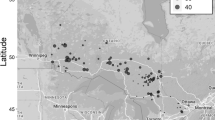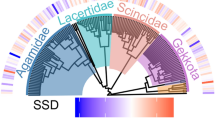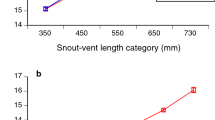Abstract
When males are the larger sex, a positive allometric relationship between male and female sizes is often found across populations of a single species (i.e. Rensch’s rule). This pattern is typically explained by a sexual selection pressure on males. Here, we report that the allometric relationship was negative across populations of a shell-brooding cichlid fish Lamprologus callipterus, although males are extremely larger than females. Male L. callipterus collect and defend empty snail shells in each of which a female breeds. We found that, across six populations, male and female sizes are positively correlated with not only sexual and fecundity selection indices, but also with shell sizes. Given their different reproductive behaviours, these correlations mean that males are required to be more powerful, and thus larger, to transport larger shells, while female bodies are reduced to the shell size to enable them to enter the shells. Among the three size selections (sexual selection, fecundity selection and shell size), shell size explained the allometry, suggesting that females are more strongly subject to size selection associated with shell size availability than males. However, the allometry was violated when considering an additional population where size-selection regimes of males differed from that of other populations. Therefore, sexual size allometry will be violated by body size divergence induced by multiple selection regimes.
Similar content being viewed by others
Abbreviations
- H:
-
height
- RMA:
-
reduced major axis
- SL:
-
standard length
- SSD:
-
sexual size dimorphism
- W:
-
width
References
Alcock 2005 Animal behaviour: an evolutionary approach, 8th edition (MA: Sinauer Associates)
Andersson M 1994 Sexual selection (NJ: Princeton University Press)
Arak A 1988 Sexual dimorphism in body size: a model and a test; Evolution 42 820–825
Blanckenhorn W U 2000 The evolution of body size: what keeps organisms small?; Q. Rev. Biol. 75 385–407
Blanckenhorn W U 2005 Behavioural causes and consequences of sexual size dimorphism; Ethology 111 977–1016
Blanckenhorn W U, Stillwell R C, Young K A, Fox C W and Ashton K G 2006 When Rensch meets Bergmann: does sexual size dimorphism change systematically with latitude?; Evolution 60 2004–2011
Borg Å, Forsgren E and Magnhagen C 2002 Plastic sex-roles in the common goby the effect of nest availability; Oikos 98 105–115
Dale J, Dunn P O, Figuerola J, Lislevand T, Székely T and Whittingham L A 2007 Sexual selection explains Rensch’s rule of allometry for sexual size dimorphism; Proc. R. Soc. London B 274 2971–2979
Emlen S T and Oring L W 1977 Ecology, sexual selection, and evolution of mating systems; Science 197 215–223
Fairbairn D J 1997 Allometry for sexual size dimorphism: pattern and process in the coevolution of body size in males and females; Annu. Rev. Ecol. Syst. 28 659–687
Fairbairn D J 2005 Allometry for sexual size dimorphism: testing two hypotheses for Rensch’s rule in the water strider Aquarius remigis; Am. Nat. (Suppl.) 116 69–84
Fairbairn D J and Preziosi R F 1994 Sexual selection and the evolution of allometry for sexual size dimorphism in the water strider, Aquarius remigis; Am. Nat. 144 101–118
Fairbairn D J, Blackenhorn W U and Szekély T 2007 Sex, size and gender roles: evolutionary studies of sexual size dimorphism (NY: Oxford University Press)
Falster, D S, Warton D I and Wright I J 2003 (S)MATR: standardized major axis tests and routines. Version 1.0; http://www.bio.mq.edu.au/ecology/SMATR
Forsgren E, Kvarnemo C and Lindstrom K 1996 Mode of sexual selection determined by resource abundance in two sand goby populations; Evolution 50 646–654
Gashagaza M M, Nakaya K and Sato T 1995 Taxonomy of small-sized cichlid fishes in the shell-bed area of Lake Tanganyika; Japan J. Ichthol. 42 291–302
Head G 1995 Selection on fecundity and variation in the degree of sexual size dimorphism among spider species (class Aranae); Evolution 49 776–781
Hedrick A V and Temeles E J 1989 The evolution of sexual size dimorphism in animals: hypotheses and tests; Trend. Ecol. Evol. 4 136–138
Kraushaar U and Blanckenhorn W U 2002 Population variation in sexual selection and its effect on size allometry in two dung fly species with contrasting sexual size dimorphism; Evolution 56 307–321
Lehtonen T and Lindström K 2008 Density-dependent sexual selection in the monogamous fish Archocentrus nigrofasciatus; Oikos 117 867–874
Lengkeek W, Didderen K, Côté I M, van der Zee E M, Snoek R C and Reynolds J D 2008 Plasticity in sexual size dimorphism and Rensch’s rule in Mediterranean blennies (Blenniidae); Can. J. Zool. 86 1173–1178
Maan M and Taborsky M 2008 Sexual conflict over breeding substrate causes female expulsion and offspring loss in a cichlid fish; Behav. Ecol. 19 302–308
Pearson D, Shine R and How R 2002 Sex-specific niche partitioning and sexual size dimorphism in Australian pythons (Morelia spilota imbricata); Biol. J. Linn. Soc. 77 113–125
Prenter J, Elwood R W and Montgomery W I 1999 Sexual size dimorphism and reproductive investment by female spiders: a comparative analysis; Evolution 53 1987–1994
Pyron M, Fincel M and Dang M 2007 Sexual size dimorphism and ecomorphology of spotfin shiner (Cyprinella spiloptera) from the Wabash River Watershed; J Freshwater Ecol. 22 687–696
Raihani G, Székely T, Serrano-Meneses M A, Pitra C and Goriup P 2006 The influence of sexual selection and male agility on sexual size dimorphism in bustards (Otididae); Anim. Behav. 71 833–838
Rensch B 1950 Die Abhangigkeit der relativen Sexualdifferenz von der Korpergroße. Bonn. Zool. Beitr. 1 58–69
Reznick D N and Endler J A 1982 The impact of predation on life history evolution in Trinidadian guppies (Poecilia reticulata); Evolution 36 160–177
Sato T 1994 Active accumulation of spawning substrate: a determinant of extreme polygyny in a shell-brooding cichlid; Anim. Behav. 48 669–678
Sato T and Gashagaza M M 1997 Shell-brooding cichlid fishes of Lake Tanganyika: their habitats and mating systems; in Fish communities in Lake Tanganyika (eds) H Kawanabe, M Hori and M Nagoshi (Kyoto: Kyoto University Press) pp 219–238
Sato T, Hirose M, Taborsky M and Kimura S 2004 Size-dependent male alternative reproductive tactics in the shell-brooding cichlid fish Lamprologus callipterus in Lake Tanganyika; Ethology 110 49–62
Schütz D and Taborsky M 2000 Giant males or dwarf females: what determines the extreme sexual size dimorphism in Lamprologus callipterus?; J. Fish. Biol. 57 1254–1265
Schütz D and Taborsky M 2005 The influence of sexual selection and ecological constraints on an extreme sexual size dimorphism in a cichlid; Anim. Behav. 70 539–549
Schütz D, Parker G A, Taborsky M and Sato T 2006 An optimality approach to male and female body sizes in an extremely size-dimorphic cichlid fish; Evol. Ecol. Res. 8 1–16
Shine R 1989 Ecological causes for the evolution of sexual dimorphism: a review of the evidence; Q. Rev. Biol. 64 419–461
Székely T, Freckleton R P and Reynolds J D 2004 Sexual selection explains Rensch’s rule of size dimorphism in shorebirds; Proc. Natl. Acad. Sci. USA 101 12224–12227
Walker S P W and McCormick M I 2009 Sexual selection explains sex-specific growth plasticity and positive allometry for sexual size dimorphism in a reef fish; Proc. R. Soc. London B 276 3335–3343
Young K A 2005 Life-history variation and allometry for sexual size dimorphism in Pacific salmon and trout; Proc. R. Soc. London B 272 167–172
Yuma M, Narita T, Hori M and Kondo T 1998 Food resources of shrimp-eating cichlid fishes in Lake Tanganyika; Env. Biol. Fish. 52 371–378
Author information
Authors and Affiliations
Corresponding author
Additional information
Supplementary movie pertaining to this article is available on the Journal of Biosciences Website at http://www.ias.ac.in/jbiosci/June2010/pp257-265/suppl.pdf
Rights and permissions
About this article
Cite this article
Ota, K., Kohda, M. & Sato, T. Unusual allometry for sexual size dimorphism in a cichlid where males are extremely larger than females. J Biosci 35, 257–265 (2010). https://doi.org/10.1007/s12038-010-0030-6
Received:
Accepted:
Published:
Issue Date:
DOI: https://doi.org/10.1007/s12038-010-0030-6




